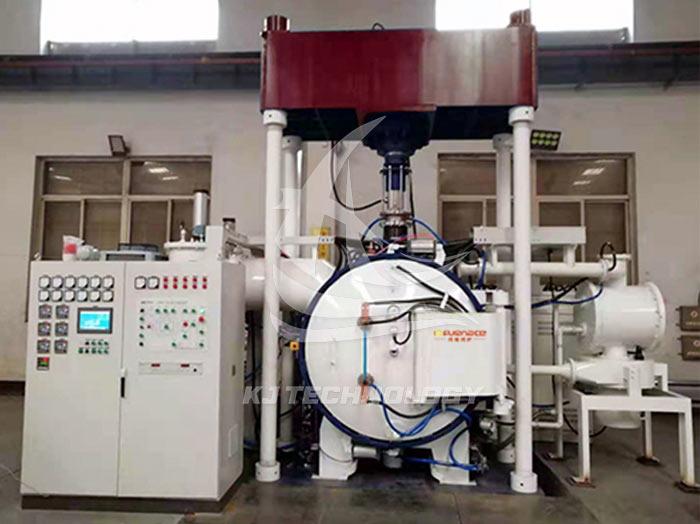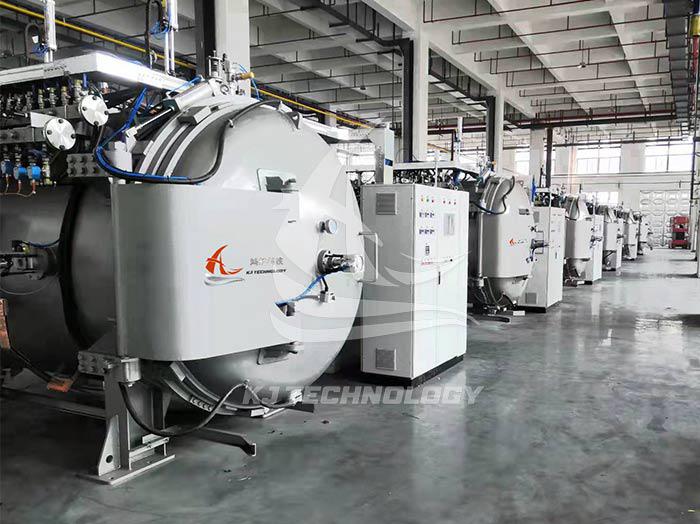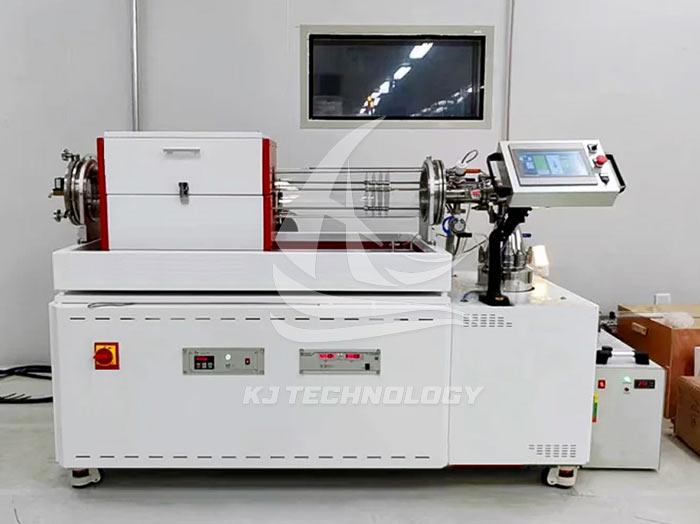Application fields of graphite high-temperature vacuum furnace
 05-23-2025 Author: KJ technology
05-23-2025 Author: KJ technology
Graphite high-temperature vacuum furnaces play a key role in multiple industrial and scientific research fields due to their high temperature, high vacuum, corrosion resistance, and precise temperature control characteristics. The following is a detailed classification and explanation of its core application areas:
1. Material preparation and processing
Advanced Ceramics and Powder Metallurgy
Application scenarios: Used for sintering high-performance ceramics such as silicon nitride and silicon carbide, as well as powder metallurgy forming of hard alloys and magnetic materials.
Technical advantages: Vacuum environment avoids oxidation, graphite heating element provides uniform high temperature field, ensuring material density and purity.
Typical case: Sintering of ceramic bearings for aerospace applications requires completion in a vacuum environment above 1800 ° C.
Graphitization of carbon materials
Application scenarios: Graphitization treatment of artificial graphite electrodes, isostatic pressed graphite, and carbon fiber reinforced composite materials.
Technical advantages: The graphite furnace body is homogeneous with the material, reducing the introduction of impurities, and promoting the growth of graphite microcrystals at temperatures above 2200 ° C.
Typical case: Graphitization of negative electrode material for lithium batteries, temperature required to reach 2800 ° C, and resistivity reduced to below 8 μ Ω· m.
Metal heat treatment
Application scenarios: Vacuum annealing and aging treatment of titanium alloys and high-temperature alloys to eliminate internal stress and improve microstructure.
Technical advantages: Vacuum environment prevents surface oxidation, and graphite induction heating achieves rapid heating (rate>50 ° C/min).
Typical case: Vacuum heat treatment of aircraft engine blades, temperature 1200 ° C, holding time 2 hours.
2. New Energy and Electronic Devices
Preparation of lithium battery materials
Application scenarios: Coating modification of negative electrode materials (natural graphite, artificial graphite), pre sintering of high nickel ternary positive electrode materials.
Technical advantages: The vacuum environment suppresses lithium volatilization, and the graphite heating element provides precise temperature control (± 1 ° C) to ensure the electrochemical performance of the material.
Typical case: NCM811 positive electrode material pre sintering, temperature 950 ° C, atmosphere argon+5% oxygen.
Semiconductors and photovoltaics
Application scenarios: directional solidification of silicon ingots, growth of silicon carbide (SiC) single crystals, and sintering of silver paste for photovoltaic applications.
Technical advantages: High vacuum (<10 ⁻ ³ Pa) reduces impurity doping, graphite crucible is heat-resistant (>2000 ° C), suitable for crystal growth.
Typical case: 6-inch SiC single crystal growth, temperature 2200 ° C, pressure 10 ⁻⁴ Pa, growth cycle 7 days.
Electronic packaging and vacuum coating
Application scenarios: Co firing of ceramic packaging shells, brazing of metalized ceramic substrates, and deposition of optical thin films.
Technical advantages: The uniformity of graphite thermal field (± 5 ° C) ensures product consistency, and the vacuum environment enhances coating adhesion.
Typical case: Microwave device ceramic packaging, temperature 1600 ° C, Ag Cu Ti brazing under nitrogen atmosphere.
3. Nuclear Energy and Aerospace
Manufacturing of nuclear fuel elements
Application scenarios: UO ₂ pellet sintering, TRISO coated particle preparation, and densification of silicon carbide cladding tubes.
Technical advantages: High vacuum environment avoids contamination by radioactive impurities, graphite molds are resistant to high temperature radiation, ensuring material density ≥ 95% TD.
Typical case: TRISO particle core sintering, temperature 1700 ° C, pressure 10 ⁻⁵ Pa, H ₂ atmosphere reduction.
Spacecraft thermal control coating
Application scenarios: Preparation of blackbody coatings on satellite surfaces and high emissivity ceramic coatings.
Technical advantages: The graphite furnace body provides a clean environment, and vacuum coating combined with ion beam assistance achieves a coating substrate adhesion force of>50MPa.
Typical case: Geosynchronous orbit satellite thermal control coating, emissivity ≥ 0.92, resistant to 500 thermal cycles (-170 ° C~+150 ° C).
4. Research and high-end manufacturing
New material research and development
Application scenarios: synthesis of ultra-high temperature ceramics (such as ZrB ₂, HfB ₂), sintering of MAX phase ceramics.
Technical advantages: Wide temperature adjustable range (room temperature~3000 ° C), supporting in-situ XRD, thermogravimetric analysis and other combined technologies.
Typical case: ZrB ₂ - SiC ultra-high temperature ceramic sintering, temperature 2000 ° C, pressure 50MPa hot pressing sintering.
Preparation of nanomaterials
Application scenario: Chemical vapor deposition (CVD) growth of graphene and carbon nanotubes.
Technical advantages: The graphite substrate has high catalytic activity, and the vacuum environment promotes precursor cracking, achieving a single-layer graphene coverage rate of>95%.
Typical case: CVD growth of monolayer graphene on copper foil, temperature 1000 ° C, CH ₄/H ₂ flow ratio 1:10.
5. Development Trends
Ultra high temperature technology: Develop graphite furnace bodies above 3000 ° C to support the processing of refractory metals such as rhenium and tantalum.
Intelligent control: Integrating AI algorithms to achieve closed-loop adaptive control of temperature, pressure, and atmosphere.
Green manufacturing: Using clean energy such as hydrogen instead of argon to reduce carbon emissions.
Multi functional integration: Combining CVD, PVD and other technologies to achieve an integrated process of "sintering+coating".
The graphite high-temperature vacuum furnace, with its unique technological advantages, has become an indispensable core equipment for high-end manufacturing and cutting-edge scientific research. With the rapid development of materials science and new energy technology, their application fields will further expand and evolve towards higher temperatures, more precise control, and greener environmental protection.








